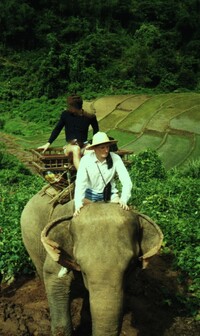Photo. Riding elephant in the Golden Triangle, Thailand. © Travel Explorations.
From this height, I enjoyed amazing views of rolling hills, green forests, and endless stretches of vibrant plants. The steep valleys in the Golden Triangle were challenging, but thanks to the elephants we could move around – without losing the balance. At first, I was worried about riding an elephant, especially when facing steep hills and rivers.
With my heart in my throat, the thought of navigating such challenging terrain on an elephant back made me nervous, and I wasn’t sure how safe it would be. Elephants are strong and sure-footed, making it easy for them to cross difficult terrain.
As the elephant walked slowly and steadily, I felt the ground shift beneath its large feet, added a sense of adventure and closeness to nature. Observed bathing of elephants in rivers by local tribesmen. Sometimes I got a chance to feed them with their favorite snacks, such as bananas and sugarcane.
The people living in the Golden Triangle, a region where the borders of Thailand, Laos, and Myanmar meet, are primarily made up of various indigenous hill tribes. These tribes have long had a complex and interconnected relationship with elephants, shaped by tradition, culture, and, more recently, tourism.
The Hill Tribes in the Golden Triangle, The Golden Triangle is home to various ethnic groups, including the Karen, Lahu, Akha, Lisu, Hmong, and Mien tribes. Each tribe has its unique culture, language, and traditional way of life. Many of these tribes live in rural, mountainous areas, practicing subsistence farming, handicrafts, and, more recently, working in tourism.
In some tribes, especially the Karen people, as we visited, elephants hold a deep cultural and spiritual significance. Elephants are viewed as revered and sacred animals, often associated with power, wisdom, and prosperity. Historically, elephants were used by tribes for practical purposes such as logging, transportation, and agricultural work. Their strength made them valuable work animals in the dense forests of the region. Elephants also play roles in tribal ceremonies and festivals, symbolising good fortune and protection for the community.
While elephants are very steady, their large size means their movements can feel slow and gentle but still substantial, so it's essential to maintain balance, especially if walking alongside them or interacting up close. Comfortable clothes and shoes that you don’t mind getting wet or dirty, as activities often involve walking through mud or water.
I can ensure you that elephants riding was a quite difference experience than riding a horse. I felt I had more control when I rode horses in my childhood. I realized quickly that it was impossible to transfer this experience over to riding elephants. Horse riding involves a more personal connection between the rider and the horse, but communicate with an elephant was almost impossible for me. Riders often form bonds with their horses and actively guiding them, making it a more engaged and interactive experience. This was not the same with elephants. Sometimes I felt the elephants made their own way, and I was just a passenger who sat on their back excited to see where they leaded me.
Stepping up onto and descending from an elephant’s back is quite different from doing the same with a horse, primarily due to the elephant’s larger size and unique physical structure. Especially I was worried about how to step down from the elephants back. Maybe I could just jump if we passed a flat terrain?
Elephants are much larger than horses, standing up to 10-13 feet tall at the shoulder, whereas horses are generally 5-6 feet tall. The height of an elephant makes the riding experience more intimidating and can feel unstable because of the great distance from the ground. Riding a horse provides a more comfortable, agile, and dynamic experience, making it easier to balance and control.
Stein Morten Lund, October 2024












